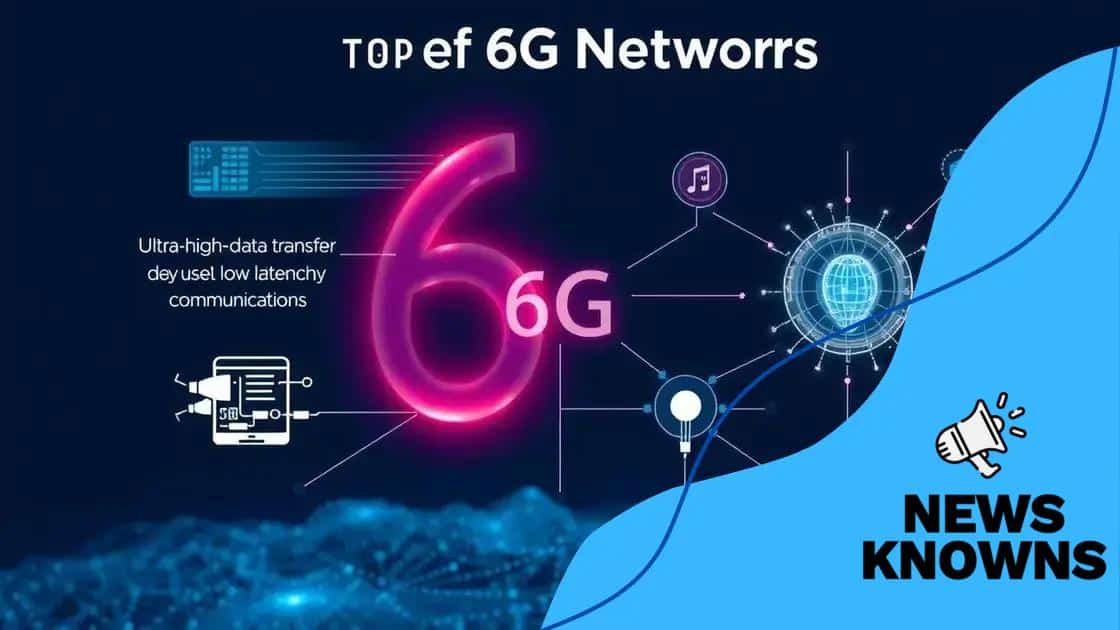The global race to develop 6G networks by 2030

Anúncios
The global race to develop 6G networks by 2030 is characterized by enhanced connectivity, ultra-fast speeds, and low latency, promising significant impacts on smart homes, education, transportation, and entertainment.
The global race to develop 6G networks by 2030 is not just about speed; it’s transforming how we think about connectivity. Have you ever wondered how it may reshape your daily experiences?
Anúncios
Understanding 6G technology and its potential
Understanding 6G technology and its potential is key to grasping the future of communication. As the world moves towards faster and more reliable networks, 6G promises to revolutionize how we connect.
What is 6G Technology?
6G is the sixth generation of mobile networks that aims to enhance the performance and capability of connectivity. Expected to launch around 2030, it will improve upon 5G with features like higher speeds, lower latency, and more reliable connections.
Key Features of 6G
- Increased data speeds exceeding 100 Gbps
- Ultra-reliable low-latency communications (URLLC)
- Integration of AI for network management
- Expanded connectivity for IoT devices
With these advancements, 6G will support new applications that were previously unimaginable. For instance, it will enhance virtual reality (VR) experiences and enable fully autonomous vehicles to operate in real-time.
Anúncios
Moreover, 6G technology is expected to facilitate seamless connectivity, bridging the digital divide and empowering remote areas. By leveraging a range of frequencies, including terahertz waves, it can connect people and devices like never before.
This technology will not only improve personal communication but also transform industries. Healthcare, for example, will benefit from real-time data transmission, allowing for remote surgeries and instant diagnostics.
As research continues, it’s essential for governments and private sectors to collaborate, ensuring a robust framework for 6G deployment. This collaboration will help address challenges such as security, infrastructure, and cost efficiency.
Major global players in the 6G race
In the 6G race, several countries and companies are emerging as major players, shaping the future of technology. These global participants are investing heavily in research and development to lead the next generation of wireless communication.
Key Countries Leading the Charge
Countries like the United States, China, and South Korea are at the forefront of the 6G technology race. Each has outlined aggressive plans to achieve significant advancements before 2030.
- The United States emphasizes innovation in AI and IoT.
- China invests heavily in infrastructure and state-sponsored research projects.
- South Korea focuses on enhancing mobile networks and expanding coverage.
This competition drives technological advancements, pushing each nation to explore unique approaches to achieving their goals. The global race is not just about speed but also about the capability and reliability of the networks being developed.
Major Companies Involved
In addition to countries, major corporations are pivotal players in this evolution. Companies like Nokia, Ericsson, Samsung, and Huawei are investing in cutting-edge research and working towards practical 6G solutions.
Nokia and Ericsson are collaborating with academic institutions to explore innovative technologies. In contrast, Samsung is focusing on integrating artificial intelligence into network operations.
Huawei is leading with extensive research in new wireless technologies and is heavily involved in international collaborations. These corporations are essential in advancing the technology and enabling real-world applications that can truly showcase the benefits of 6G.
This dynamic landscape presents both opportunities and challenges as nations and companies vie for leadership. Understanding the players involved is crucial for grasping the developments that will shape our connected future.
Key features expected in 6G networks

The key features expected in 6G networks promise a leap forward in communication technology, aiming to enhance user experiences and support new applications. These advanced characteristics will set 6G apart from its predecessors, particularly 5G.
Ultra-High Speeds
One of the standout features of 6G is the expected data speed, which could surpass 100 Gbps. This means downloading full-length movies in seconds and streaming ultra-high-definition content seamlessly.
Low Latency
With latency levels potentially as low as 1 millisecond, 6G will bring real-time interactions to a new level. This feature is crucial for applications in fields like remote surgery and autonomous driving, where every moment counts.
- Instantaneous response times for critical applications.
- Enhanced user experience in online gaming and virtual reality.
- Improved performance for smart city infrastructure.
These low-latency capabilities will deeply impact various industries, making processes faster and more efficient.
Massive Connectivity
6G networks are projected to connect a vastly increased number of devices. The focus will be on enabling the Internet of Things (IoT) to grow exponentially. By allowing billions of devices to communicate simultaneously, the networks can create smarter homes and cities.
Furthermore, the enhanced connectivity will improve automation across numerous sectors, from agriculture to healthcare. Devices will be able to share information quickly, providing valuable data for critical decision-making.
Integration of AI and Advanced Technologies
Artificial intelligence will play a significant role in managing the complexity of 6G networks. Through AI algorithms, networks can optimize performance, address issues proactively, and enhance user experiences.
Also, 6G is expected to utilize terahertz frequencies, enabling faster data transmission over shorter distances. This technology allows for seamless and ultra-fast connections, maximizing the capabilities of the network.
Challenges facing the development of 6G
The development of 6G technology presents several challenges that must be addressed to ensure its successful implementation. These obstacles range from technical issues to regulatory concerns, each requiring careful consideration.
Technical Challenges
One of the primary obstacles is the integration of new technologies, such as terahertz frequencies. These frequencies have a higher potential for data transfer; however, they also face issues with range and penetration. Ensuring effective connectivity in urban and rural settings is essential.
Infrastructure Development
The infrastructure necessary for 6G must also be significantly upgraded. This includes installing new base stations and enhancing existing networks to support the higher data rates expected from 6G. Transitioning from 5G to 6G requires a thoughtful investment in physical infrastructure.
- Building new cell towers to improve coverage.
- Upgrading fiber optic cables to handle increased data traffic.
- Implementing advanced hardware to manage complex networks.
Urban areas will require denser networks, while rural areas will need innovative solutions to ensure connectivity. Balancing these needs poses a significant challenge.
Regulatory Issues
Another major challenge is navigating regulatory frameworks. As countries innovate and develop their own 6G solutions, consistent global standards need to be established. Different regulations can lead to fragmentation, causing delays in deployment.
Governments must collaborate to create policies that foster innovation while ensuring equitable access to 6G networks. Addressing cybersecurity and privacy concerns also remains crucial, as the increase in connectivity comes with greater risks.
Industry Collaboration
Finally, successful 6G development hinges on collaboration between various stakeholders, including tech companies, governments, and academia. This requires a unified approach to research and development.
Building partnerships can help share resources, knowledge, and expertise, enabling faster progress on shared objectives. Overcoming these challenges will take time and require a concerted effort from all involved.
Impacts of 6G on everyday life
The impacts of 6G on everyday life will be profound and far-reaching, changing how we interact with technology and each other. As this technology evolves, it promises to reshape our daily experiences in numerous ways.
Enhanced Connectivity
One of the most significant impacts of 6G will be enhanced connectivity. With the ability to connect more devices at once, our homes and cities will become smarter and more efficient. Everyday items like refrigerators and toasters can communicate with each other, optimizing energy use and improving convenience.
- Smart homes will allow for remote monitoring and control of appliances.
- Healthcare devices will offer real-time health tracking.
- Enhanced public transport systems will provide real-time updates to commuters.
This seamless interconnectivity will transform how we manage our homes and interact with services.
Transforming Work and Education
6G will also revolutionize work and education by making remote collaboration easier and more effective. High-speed, low-latency connections will support advanced video conferencing, virtual reality (VR) classrooms, and even remote surgeries.
Imagine attending a lecture in a virtual environment where you can interact with your classmates just as if you’re in the same room. New opportunities for learning and working will be available, giving people greater flexibility.
Advancements in Entertainment
Entertainment will undergo a major transformation with 6G. Fast data speeds will enable ultra-high definition streaming, allowing users to watch movies and play video games without any buffering.
For gamers, 6G can support cloud gaming, where high-performance games are streamed directly without the need for powerful local hardware. This accessibility will provide greater opportunities for enjoyment.
Smart Cities and Transportation
6G could lead to the development of smart cities, where data from connected devices is used to improve city life. Traffic management systems will analyze data from vehicles to optimize traffic flow, reducing congestion and pollution.
Furthermore, autonomous vehicles will need reliable 6G connectivity to communicate with each other and manage operations safely. These advancements will not only enhance mobility but also promote sustainability.
FAQ – Frequently Asked Questions about 6G Technology
What is 6G technology?
6G technology is the sixth generation of mobile networks that promises faster speeds, lower latency, and improved connectivity for devices.
How will 6G impact my daily life?
6G will enhance everyday experiences through smarter homes, faster internet services, and better communication technologies.
What are the main challenges in developing 6G?
Challenges include technical issues, infrastructure upgrades, regulatory hurdles, and ensuring collaboration among various stakeholders.
When can we expect the rollout of 6G networks?
6G is expected to begin rolling out around 2030, with ongoing research and development throughout the coming years.





